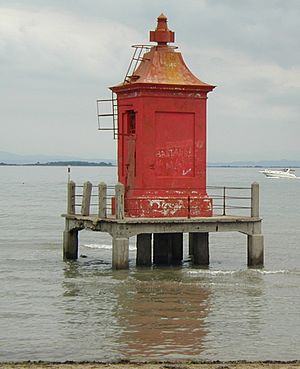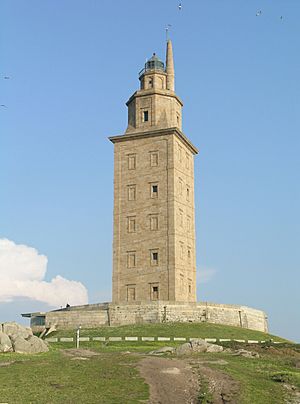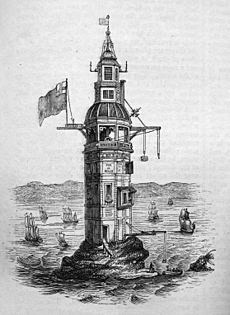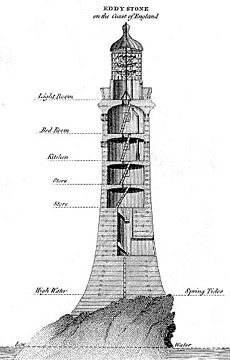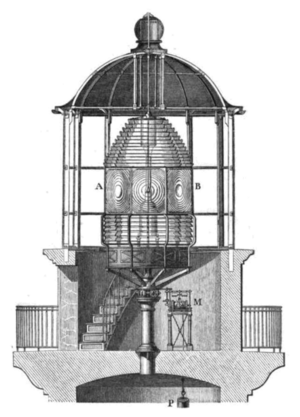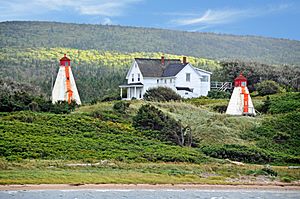Lighthouse facts for kids
A lighthouse is a tall building with a bright light at its top. Lighthouses are usually built on the coast of an ocean or lake. Their main job is to help ships avoid crashing into the shore by sending out a strong light towards the sea. This light often spins, making it look like a flashing signal to ships. A special Fresnel lens usually covers the light, helping it travel very far.
One of the most famous lighthouses ever was the Lighthouse of Alexandria. It stood on an island called Pharos near the coast of Egypt. Because of this island's name, the word for lighthouse in many languages today comes from Pharos. Most lighthouses around the world are now automatic, meaning they don't need people to operate them all the time.
History of Lighthouses
Early Lighthouses
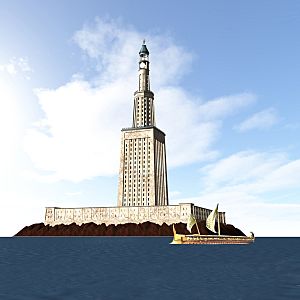
Long ago, before proper ports existed, sailors used fires lit on hilltops to guide their way. People soon realized that putting the fire on a raised platform made it easier to see. This idea led to the first lighthouses. Ancient lighthouses mostly showed sailors where a port entrance was, rather than warning them about dangerous rocks or reefs.
The most famous ancient lighthouse was the Pharos of Alexandria in Egypt. Sadly, it fell apart after several earthquakes between the years 956 and 1323.
The Tower of Hercules in A Coruña, Spain, is an ancient lighthouse that is still standing today. It helps us understand how these old structures were built. We can also see pictures of ancient lighthouses on old coins and mosaics.
Modern Lighthouse Building
The way lighthouses were built changed a lot around the 1700s. This was when transatlantic trade grew, and more ships crossed the ocean. New building methods and better lighting equipment allowed engineers to create bigger and stronger lighthouses, even in the open sea. Now, lighthouses became important for warning ships about dangers like hidden rocks or reefs.
The Eddystone Rocks in the English Channel were very dangerous for ships. The first lighthouse built there was a wooden tower, finished in 1698 by Henry Winstanley. It was the first lighthouse in the world to be fully exposed to the open sea.
Later, a civil engineer named John Smeaton rebuilt the Eddystone lighthouse between 1756 and 1759. His design was a huge step forward. He shaped his lighthouse like an oak tree and used granite blocks. He also rediscovered a Roman type of concrete called "hydraulic lime" that could set underwater. Smeaton developed a way to lock the granite blocks together using special joints and pins. This made the tower much stronger. His lighthouse became the model for all future lighthouses.
Robert Stevenson was another important engineer who designed many lighthouses. His greatest achievement was building the Bell Rock Lighthouse in 1810. This amazing structure was based on Smeaton's design but had new features, like lights that rotated and flashed different colors (red and white). Stevenson worked for the Northern Lighthouse Board for almost 50 years, creating and improving many lighthouses. He also invented special cranes to help build them.
Alexander Mitchell designed the first screw-pile lighthouse. These lighthouses were built on giant metal screws drilled into the sandy or muddy seabed. The first one was lit in 1841 at the mouth of the River Thames.
Better Lighting for Lighthouses
Early lighthouses used fires made of wood or coal. In 1782, a Swiss scientist named Aimé Argand invented the Argand lamp. This lamp had a steady, smokeless flame and changed lighthouse lighting forever. It used whale oil or vegetable oil as fuel. The Argand lamp became the standard for lighthouses for over 100 years.
In 1875, the South Foreland Lighthouse was the first to successfully use an electric light. It had powerful carbon arc lamps powered by a steam engine. Later, John Richardson Wigham developed a system for using coal gas to light lighthouses, making them even brighter.
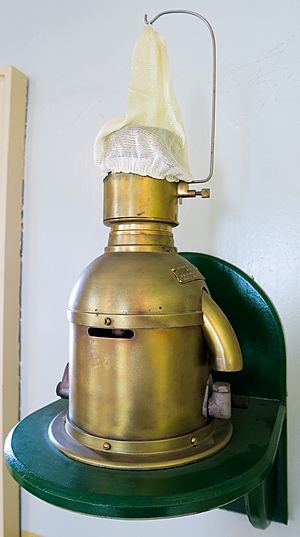
In 1901, Arthur Kitson invented the vaporized oil burner. This burner made the light six times brighter than traditional oil lamps. The Dalén light, invented by Swedish engineer Gustaf Dalén, made gas lighting very popular. He also invented the 'sun valve', which could turn the lighthouse light on automatically at night and off during the day. This technology was used in most lighthouses from the 1900s to the 1960s, when electric lights became common.
Advanced Optical Systems
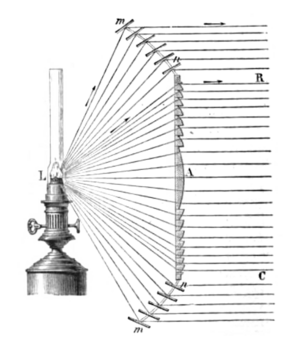
Once the Argand lamp provided a steady light, engineers could use special lenses to make the light even stronger and more focused. In 1763, William Hutchinson created the first practical optical system. This system gathered the light and sent it out in a strong, focused beam, making it much more visible. This also allowed for the first revolving lighthouse beams, where the light would flash on and off for sailors.
A French physicist named Augustin-Jean Fresnel developed the amazing Fresnel lens for lighthouses. His design allowed for very large lenses that were much thinner and lighter than traditional ones. A Fresnel lens can also capture more light from the lamp, making the lighthouse visible from much greater distances.
The first Fresnel lens was used in 1823 in the Cordouan lighthouse in France. Its light could be seen from over 20 miles (32 km) away! Fresnel’s invention made lighthouse lamps four times brighter, and his system is still used today.
Lighthouses Today
With the invention of electricity and automatic lamp changers, lighthouse keepers became less necessary. For many years, keepers still worked in lighthouses, partly because they could help with rescues if needed. However, new navigation tools like the Global Positioning System (GPS) have made non-automated lighthouses less common around the world. In Canada, though, there are still about 50 lighthouses with keepers.
Most modern lighthouses use solar-powered batteries and have a single flashing light on a steel tower.
Famous Lighthouse Builders
While John Smeaton is famous for designing the third Eddystone Lighthouse, many other builders are known for creating multiple lighthouses. The Stevenson family in Scotland, including Robert, Alan, David, and Thomas, made lighthouse building their family business for three generations.
An Irishman named Alexander Mitchell invented and built several screw-pile lighthouses, even though he was blind. James Nicholas Douglass from England was even knighted for his work on lighthouses.
In the United States, Lieutenant George Meade of the United States Army Corps of Engineers built many lighthouses before he became a famous general in the Battle of Gettysburg. Colonel Orlando M. Poe designed some of the most unique lighthouses in difficult locations on the U.S. Great Lakes.
After the Crimean War (1853–1856), a French naval officer named Marius Michel Pasha built nearly 100 lighthouses along the coasts of the Ottoman Empire in just 20 years.
Lighthouse Technology
Powering the Light
In a lighthouse, the actual light source is called the "lamp," and the system that focuses the light is called the "lens" or "optic." Early lighthouses used open fires or candles. In the late 1700s, the Argand lamp and special reflectors were introduced.
Whale oil was also used as fuel. In the 1870s, kerosene became popular. Around the 1900s, electricity and acetylene gas began to replace kerosene. The Dalén light system, which used acetylene gas, could automatically turn the lamp on at night and off at dawn.
During the Cold War, some remote Soviet lighthouses were powered by special generators called radioisotope thermoelectric generators (RTGs). These could provide power day and night without needing fuel or maintenance. However, after the Soviet Union broke up, many of these lighthouses were left without care, and some have been damaged or had their dangerous radioactive parts stolen.
The Lighthouse Lens

Before modern strobe lights, lighthouses used large lenses to focus the light from a continuous source. These lenses redirected the light rays into a strong, narrow beam that swept across the water. This made the light visible from much farther away and allowed each lighthouse to have a unique flashing pattern.
This focusing was done with a rotating lens assembly. In older lighthouses, the light came from a kerosene lamp or an oil lamp. The lenses were rotated by a clockwork system powered by weights, which lighthouse keepers had to wind up every few hours. Sometimes, the lens assembly floated in liquid mercury to reduce friction and make it spin smoothly. In newer lighthouses, electric lights and motors powered by diesel generators are used.
To focus light efficiently from a large lamp, you need a very wide lens. If a normal lens were used, it would be extremely thick and heavy. The Fresnel lens solved this problem. It could focus 85% of a lamp's light, compared to only 20% with older reflectors. Its design allowed for large lenses that were much lighter and thinner.
Fresnel lighthouse lenses are ranked by "order," which describes their focusing power. A first-order lens is the largest, most powerful, and most expensive, while a sixth-order lens is the smallest. The order depends on the lens's focal length. Lighthouses along the coast usually use first, second, or third-order lenses. Smaller harbor lights use fourth, fifth, or sixth-order lenses.
Some lighthouses, like those at Cape Race and Makapuu Point, used even more powerful lenses called hyperradiant Fresnel lenses.
Today, many Fresnel lenses have been replaced by rotating "aerobeacons" that need less maintenance. Modern automated lighthouses often use a single, very bright light that flashes briefly in all directions. Newer ideas include "Vega Lights" and lights made with light-emitting diode (LED) panels.
Light Patterns and Signals
In any lighthouse design, instead of seeing a continuous dim light, an observer sees a much brighter light for short periods. These bright flashes are arranged to create a unique "light characteristic" or pattern for each lighthouse. For example, the Scheveningen Lighthouse flashes for 2.5 seconds, then 7.5 seconds, and so on. Some lights have colored sections (usually red or green) to show safe water areas or warn about dangerous shoals. Modern lighthouses often have special reflectors or Racon transponders that give them a unique signal on radar.
Lighthouse Building
Different Designs
For a lighthouse to be effective, its lamp must be high enough for sailors to see it before they reach danger.
If dangerous sandbanks are far from a flat, sandy beach, a tall, sturdy masonry lighthouse is built. These are often round to reduce the effect of strong winds, like the Cape May Lighthouse. Smaller versions are used as harbor lights to mark the entrance to a port, such as the New London Harbor Light.
If there's a tall cliff, a smaller structure might be placed on top, like at Horton Point Light. However, sometimes a cliff can be too high, especially where low clouds or fog are common. In these cases, lighthouses are built lower down the cliff so their light can still be seen during foggy weather, as at Point Reyes Lighthouse. The Old Point Loma Lighthouse had this problem and was replaced in 1891 with a lower one.
As technology improved, lighthouses built in the 1900s often used prefabricated metal structures. These usually have a narrow core surrounded by an open metal framework, like the Finns Point Range Light.
Sometimes, a lighthouse needs to be built directly in the water. "Wave-washed" lighthouses are strong masonry structures designed to withstand powerful waves, such as the Eddystone Lighthouse in Britain. In shallower bays, screw-pile lighthouses are built. These have iron frameworks screwed into the seabed, with a wooden structure on top, like the Thomas Point Shoal Light. In cold places where ice can damage screw piles, steel "caisson" lighthouses are used, such as the Orient Point Light.
In waters that are too deep for a fixed structure, a lightship might be used instead of a lighthouse, like the former lightship Columbia. Most of these have now been replaced by fixed platforms, similar to those used for offshore oil rigs.
Parts of a Lighthouse
While lighthouses look different depending on their location and purpose, they usually have similar parts.
A "light station" includes the lighthouse tower and all other buildings, like the keeper's living quarters, fuel storage, boat house, and fog horn building. The lighthouse itself is the tower that holds the "lantern room" where the light and lens are located.
The lantern room is the glass-enclosed area at the top of the tower. Its glass panes are held by metal bars. At the very top of the lantern room is a special vent that lets out smoke from the lamps and heat that builds up inside. A lightning rod and grounding system protect the lighthouse from lightning strikes.
Just below the lantern room is usually a "Watch Room" or "Service Room." This is where keepers stored supplies, prepared the lamps for the night, and often stood watch. The clockwork mechanisms that rotated the lenses were also kept here. Outside the watch room or lantern room, there's often an open platform called the "gallery." This was mainly used for cleaning the outside of the lantern room windows.
Lighthouses that are close to each other and look similar are often painted in a unique pattern. This pattern, called a "daymark," helps sailors recognize them during the day. The black and white spiral pattern of the Cape Hatteras Lighthouse is a famous example. The Race Rocks Light in Canada is painted with black and white horizontal bands to stand out against the horizon.
Range Lights
When two fixed points on land line up, they create a "line of position" that sailors can use. This is called a "range" in the U.S. and a "transit" in Britain. Ranges are very useful for guiding a ship precisely through a narrow channel, like a river. If these landmarks are lit by lighthouses, nighttime navigation becomes possible.
These paired lighthouses are called "range lights" in the U.S. and "leading lights" in the UK. The light closer to the ship is called the "front range" or "beacon," and the one farther away is the "rear range." The rear range light is almost always taller than the front one.
When a ship is on the correct course, the two lights will appear to line up perfectly, one above the other. If the sailor sees them out of alignment, it tells them which way to steer to get back on the right path.
Images for kids
-
The Lighthouse of Praia da Barra on the west coast of Portugal.
-
The original Winstanley lighthouse at Eddystone Rock, from 1813.
-
Marjaniemi Lighthouse, a 19th-century lighthouse on the Hailuoto island in Finland.
-
Point Danger lighthouse in Queensland, Australia, 1971.
See also
 In Spanish: Faro para niños
In Spanish: Faro para niños


